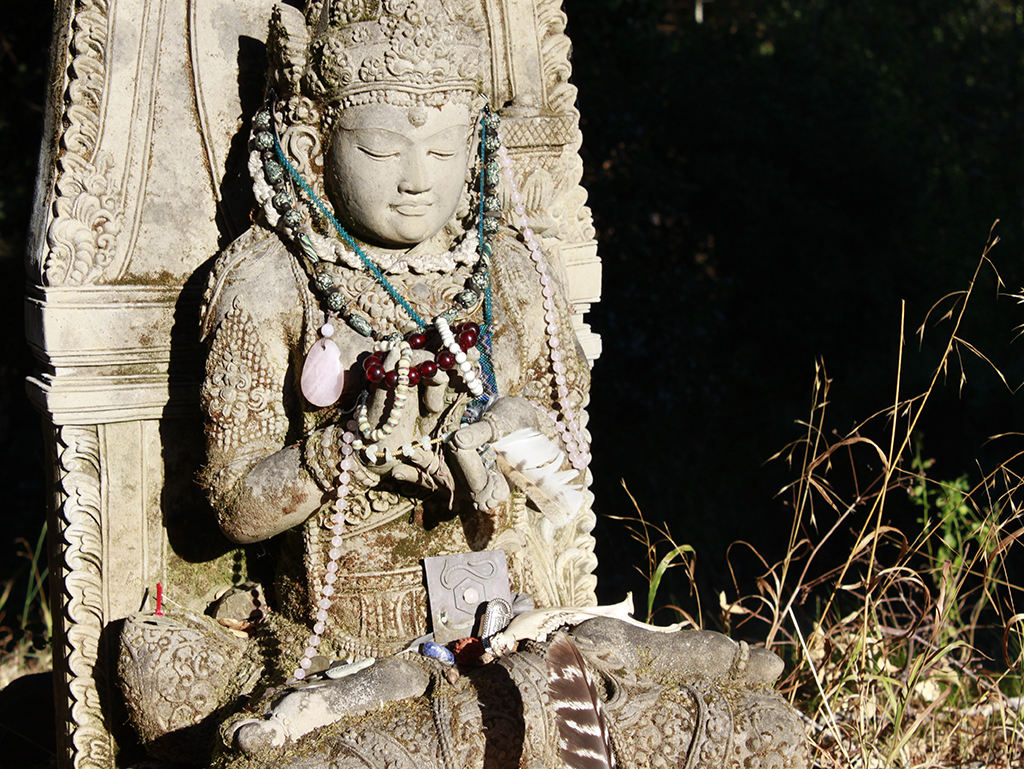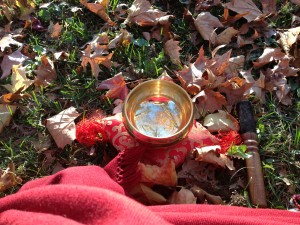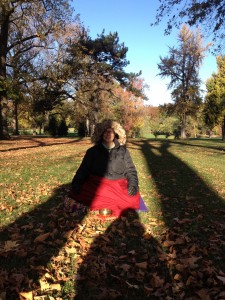Back on Monday, Nov 19
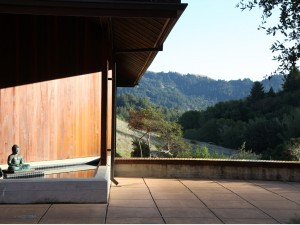 I’m on my way to Spirit Rock for the next Dedicated Practitioner Program (DPP) retreat and then to spend a few days with Dharma friends I’ve met through the program. The DPP teachings are awesome, but I’m finding that the real jewel of the program is the connection with fellow practitioners.
I’m on my way to Spirit Rock for the next Dedicated Practitioner Program (DPP) retreat and then to spend a few days with Dharma friends I’ve met through the program. The DPP teachings are awesome, but I’m finding that the real jewel of the program is the connection with fellow practitioners.
This will be the 4th of 5 retreats. We started in May of 2011, and will finish in May 0f 2013. I’ll be sad to see it end. But, actually, this is just the beginning.
I’ll be back in DharmaTown on Monday, Nov. 19. In the mean time, I leave you with this photo by staffer, Walt Opie, taken from the courtyard in front of the Spirit Rock meditation hall. I’ll be standing at exactly this spot quite often over the next several days. Wishing, in gladness and in safety: May all beings be at ease.
This photo is available to download as wallpaper for your computer desktop by clicking here.
Abbra Caddabra!
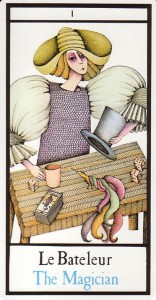 This month’s DPP homework has arrived and one of the topics is The Five Aggregates. This is a key teaching, which is hard to fully get, but one that’s certainly intriguing. The Buddha looked at his experience and found that everything he felt himself to be could be categorized into five groups (aggregates), and that none of these were really substantial, none were “who he was.”
This month’s DPP homework has arrived and one of the topics is The Five Aggregates. This is a key teaching, which is hard to fully get, but one that’s certainly intriguing. The Buddha looked at his experience and found that everything he felt himself to be could be categorized into five groups (aggregates), and that none of these were really substantial, none were “who he was.”
The five categories are:
(1) the body
(2) the feeling that experiences are pleasant, unpleasant, or neutral
(3) the perception/recognition of knowing what things are (oh, yeah, that’s a bird!)
(4) the thought patterns that include emotions, attitudes, fantasies, likes/dislikes, etc.
(5) the consciousness that is aware of things that are seen, heard, smelled, touched, tasted, or thought
One of our readings is the Phena Sutta, in which the Buddha offers metaphors for the nature of each of these five. The body, he says, is like a pile of foam. Feelings, like a bubble in a pond. Perception, like a mirage. Thought patterns, like a banana tree (which has no core). And conscious, he says, is like a magic trick.
“Now suppose that a magician or magician’s apprentice were to display a magic trick at a major intersection, and a man with good eyesight were to see it, observe it, and appropriately examine it. To him….it would appear empty, void, without substance: for what substance would there be in a magic trick?
“In the same way, a monk sees, observes, and appropriately examines any consciousness that is past, future or present; internal or external; blatant or subtle; common or sublime; far or near. To him….it would appear empty, void, without substance: for what substance would there be in consciousness?”
Try it!
Dharma Desktop
The Spirit Rock e-Newsletter just arrived with lots of interesting stuff, including a free, hi-res download of this photo taken at Spirit Rock by Walt Opie….and which makes very cool wallpaper for you computer desktop! (The full image is horizontal and proportioned to fit most computer screens, but it’s cropped here to fit the blog window.) Check it out here (scroll down).
Attend to the Peacefulness
Last night at the Hi-Pointe Sitting Group, I offered the following instructions from a really wonderful little book by Ajahn Sucitto, “Kamma and the End of Kamma.” (Available as a free download here.)
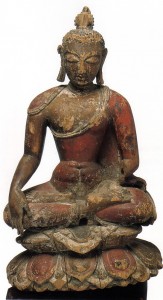 Sit still in a quiet and settled place in a way that feels comfortable. Relax your eyes, but let them stay open or half-open, with a relaxed gaze. Be aware of the sensation of your eyeballs resting in the eye-sockets (rather than focusing on what you can see). Be sensitive to the tendency for the eyes to fidget, and keep relaxing that.
Sit still in a quiet and settled place in a way that feels comfortable. Relax your eyes, but let them stay open or half-open, with a relaxed gaze. Be aware of the sensation of your eyeballs resting in the eye-sockets (rather than focusing on what you can see). Be sensitive to the tendency for the eyes to fidget, and keep relaxing that.
Bring your attention to the sensations of your hands, then your jaw and tongue. See if they, too, can take a break from being ready to act or be on guard. Let your tongue rest in the roof of your mouth. Then sweep that relaxing attention from the corners of the eyes and around the head, as if you were unfastening a bandana. Let the scalp feel free.
Let your eyes close. As you relax all around your head and face, bring that quality of attention, slowly, gradually, down over your throat. Loosen up there, as if allowing each out-breath to sound an inaudible drone.
Keeping in touch with these places in your body, be aware of the flow of thoughts and emotions that pass through your mind. Listen to them as if you’re listening to flowing water, or the sea. If you find yourself reaching to them, bring your attention to the next out-breath, continuing to relax through the eyes, throat and hands.
While maintaining awareness of the overall presence of your body, practice stepping back from, or letting go of, any thoughts and emotions that arise. Don’t add to them; let them pass. Whenever you do that, notice the sense of spaciousness, however brief, that seems to be there, behind the thoughts and feelings. Attune to the peacefulness of that.
Feeling the peacefulness of that, take it in. Rather than demand or try to achieve calm, make a practice of quietly offering peace to the energies that pass through you.
Thank You, Johannes
Last night was the last time that Maplewood Metta will be held at Johannes’ house. Johannes has been amazingly generous in opening his home to us every Tuesday evening for more than a year, and now it’s time to let go…and allow someone else to enjoy the benefits of practicing generosity!
Starting November 27, Maplewood Metta will relocate to Jon Yaffe’s house, also in Maplewood. As always, we will meet from 6:30 to 7:30 pm. For more information, contact Jon by email here.
Thank you, Johannes.
May you be happy, safe, healthy, and free. For your kindness and gracious hospitality, I offer the Metta Sutta:
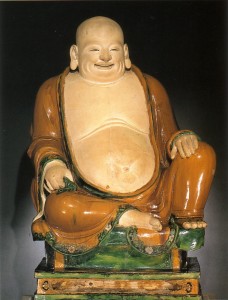 This is what should be done
This is what should be done
By one who is skilled in goodness,
And who would know the path of peace:
Let them be able and upright,
Straightforward and gentle in speech.
Humble and not conceited,
Contented and easily satisfied,
Unburdened with duties and frugal in their ways.
Peaceful and calm, and wise and skillful,
Not proud and demanding in nature.
Let them not do the slightest thing
That the wise would later reprove.
Wishing: In gladness and in safety,
May all being be at ease.
Whatever living beings there may be;
Whether they are weak or strong, omitting none,
The great or the mighty, medium, short or small,
The seen and the unseen,
Those living near and far away,
Those born and to-be-born–
May all beings be at ease.
Let none deceive another,
Or despise any being in any state.
Let none through anger or ill-will
Wish harm upon another.
Even as a mother protects with her life
Her child, her only child,
So with a boundless heart
Should one cherish all living beings;
Radiating kindness over the entire world:
Spreading upwards to the skies,
And downwards to the depths;
Outwards and unbounded,
Freed from hatred and ill-will.
Whether standing or walking, seated or lying down
Free from drowsiness,
One should sustain this recollection.
This is said to be the sublime abiding.
By not holding to fixed views,
The pure-hearted one, having clarity of vision,
Being freed from all sense-desires,
Is not born again into this world.
Mindfulness at Work
Last night the Dancing with Life KM group met, but we never got around to talking about the book. We sat for 20 minutes, as usual, and then went around the circle, giving everyone a chance to check in and to share what’s going on in their life. When it came to me, I started talking about the retreat I just came back from…about Mirabai..and people started asking questions, and then we got into how important it is to go on retreats, especially with a good teacher, and then about how to find one….and before we knew it, the time was up!
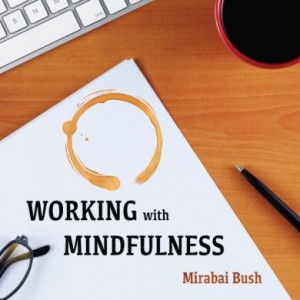 So in keeping with the theme of finding a good teacher, I thought I’d post just one more thing about Mirabai. She’s got a new CD, called Working with Mindfulness, which can be downloaded here. It’s about practicing mindfulness at work and it has a series of short, guided meditations including: Email with Intention, Reminders for a Mindful Workplace and Building Better Work Relationships.
So in keeping with the theme of finding a good teacher, I thought I’d post just one more thing about Mirabai. She’s got a new CD, called Working with Mindfulness, which can be downloaded here. It’s about practicing mindfulness at work and it has a series of short, guided meditations including: Email with Intention, Reminders for a Mindful Workplace and Building Better Work Relationships.
Here’s what Mirabai says about the CD: You cannot control your stressors at work, but you can learn to manage your responses to them. “Working with Mindfulness” offers exercises for the workplace adapted from traditional Buddhist practices that I’ve taught to hundreds of people at Google, Monsanto, Hearst, Seva Foundation, Fetzer Institute, and the Wilderness Society. Participants report reduced stress, increased productivity, and openness to creative problem solving. Most importantly, they felt that their relationships improved.
Sitting in the Cold
 The Sitting in the Park group met on Saturday morning. It was cold (35 degrees!) but lovely. Next Saturday, Nov 3, will be your last chance to join us before we take a break until next spring.
The Sitting in the Park group met on Saturday morning. It was cold (35 degrees!) but lovely. Next Saturday, Nov 3, will be your last chance to join us before we take a break until next spring.
Where: near the Farmers’ Market in Tower Grove Park
When: 8:30 to 9:00 am
What To Do
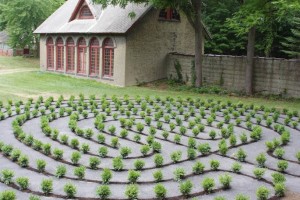 I think the most meaningful practice we did at the retreat last weekend was to walk the labyrinth. We did it in a group–in silence–each of us forming a question for reflection as we entered the mandala.
I think the most meaningful practice we did at the retreat last weekend was to walk the labyrinth. We did it in a group–in silence–each of us forming a question for reflection as we entered the mandala.
My question…I thought….had to do with earning a living. But right away it became clear that the real question was: What is my work? And when the answer came right away–that my real work is to follow the path–then all the other what-should-I-do’s just fell away. Because when I see that my work is to follow the path, then the only thing I need to do, is to take the next step. Not the step that’s three steps ahead of me. The next step. The one that’s right there in front of me. That’s the step I need to take. And since I’m on a path that’s clear and well defined, there’s really no decisions that need to be made. Just follow the path. And keep moving.
It sounds simplistic. Cliched. “One-Day-At-A-Time,” and all that. But walking the labyrinth, just inches behind the person in front of me, continually moving, listening, breathing….I “got” it in a way that I don’t think I would have, any other way.
So now I know what to do:
Stay on path.
Take the next step.
Listen
Last night at the Hi-Pointe Sitting Group, I read one of the poems Mirabai read to us at the retreat. (Partly as a way of bringing her energy back home with me, but mostly because I was awe-struck by the beauty of it.)
Out of the Mouths of a Thousand Birds, by Hafiz (translated by Daniel Ladinsky)
 Listen–
Listen–
Listen more carefully to what is around you
Right now.
In my world
There are the bells from the clanks
Of the morning milk drums,
And a wagon wheel outside my window
Just hit a bump
Which turned into an ecstatic chorus
Of the Beloved’s Name.
There is the Prayer Call
Rising up like the sun
Out of the mouths of a thousand birds.
There is an astonishing vastness
Of movement and Life
Emanating sound and light
From my folded hands
And my even quieter simple being and heart.
My dear,
Is it true that your mind
Is sometimes like a battering
Ram
Running all through the city,
Shouting so madly inside and out
About the ten thousand things
That do not matter?
Hafiz, too,
For many years beat his head in youth
And thought himself at a great distance,
Far from an armistice
With God.
But that is why this scarred old pilgrim
Has now become such a sweet rare vintage
Who weeps and sings for you.
O listen–
Listen more carefully
To what is inside of you right now.
In my world
All that remains is the wondrous call to
Dance and prayer
Rising up like a thousand suns
Out of the mouth of a
Single bird.
What Is Alive
One of the contemplative practices we did at the retreat was a free-writing exercise, which began with this prompt: What is alive for me in this moment is.... We wrote for several minutes starting with that. Then we were asked to choose a sentence from what we’d just written, and use that as a prompt.
What was alive for me in the beginning was a sense of joy and appreciation. I wrote a lot about being happy to see Mirabai, about being able to speak Italian with one of the participants, the beauty of the room, the light, the wood, the stained glass windows, but then I wrote: There is a sharp, bright, pain-point in my knee, which is also alive.
And for some reason, that’s the sentence I chose to use as the prompt for the second part. I wrote:
 There is a sharp, bright, pain-point in my knee, which is also alive. But it does not overwhelm me. It breathes, but it does not consume all the air in my mind. It comes. And it goes. It disturbs me sometimes. Frightens me, even.
There is a sharp, bright, pain-point in my knee, which is also alive. But it does not overwhelm me. It breathes, but it does not consume all the air in my mind. It comes. And it goes. It disturbs me sometimes. Frightens me, even.
Boo!
Death is behind the mask of this pain. No, not exactly death. Growing-Old is it’s name. I get afraid of it. Of it changing me. Making me unable to walk up the stairs without wincing. Unable to sit on the floor…or to get back up.
But fear is not alone at the door. There is also Joy — luminous, glowing, radiant, lighting the way for the others who stand sweating and itchy under their masks. All are holding bowls. They are asking for candy. Wanting to frighten me. Or enchant. They say: Here we are. Feed us.
I must open the door.
But I can choose whom to feed.
All may come in.
All are welcome to leave.
(image from “Offerings,” by Danielle and Olivier Follmi)

